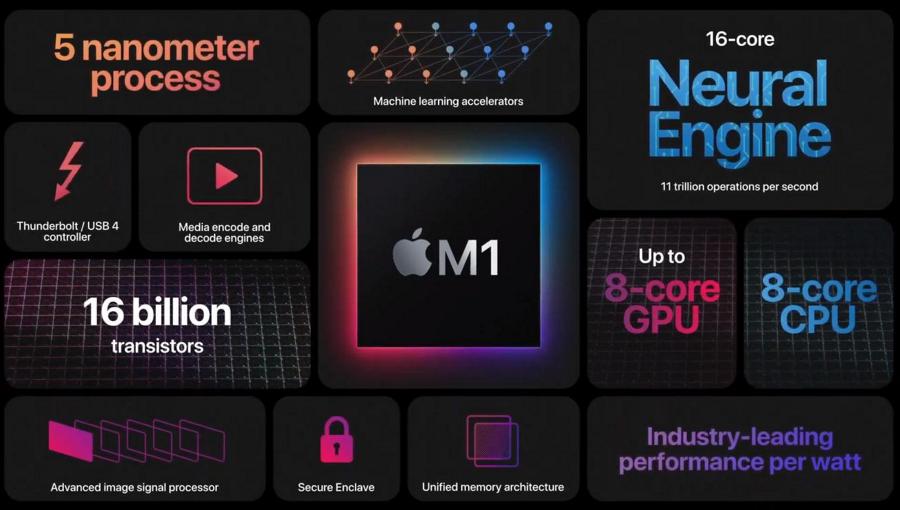Since Apple announced the Arm-based MacBook during the "One More Thing" event, people have once again started discussing the difference between Arm and x86 and what each brings new to the table compared to the table. In this post, we will take a looking at the difference between Arm and x86, and dive deeper into Apple’s transition into Arm-based Apple Silicon from Intel’s x86 architecture. Apple has used TSMC’s 5nm process node for the M1 silicon and it is making some big claims about it. First, Apple is advertising it as the world’s best performance per watt. It has also made a tremendous improvement with battery life. The new 13-inch MacBook is now claimed to have almost twice the battery life.
Apple has used TSMC’s 5nm process node for the M1 silicon and it is making some big claims about it. First, Apple is advertising it as the world’s best performance per watt. It has also made a tremendous improvement with battery life. The new 13-inch MacBook is now claimed to have almost twice the battery life.
Apple switches from Intel's x86 to Arm
Instruction Set Architecture
To the core, Arm and x86 are two CPU architecture with different instruction sets. An instruction set is the collection of basic operations that a CPU can complete. Here, Arm is an example of Reduced Instruction Set Computing (RISC) whereas x86 is based on Complex Instruction Set Computing (CISC). The difference?- CISC tries to include instruction that can implement high-level commands directly. This in turn simplifies the compilation process but results in a set with more complex instructions.
- RISC on the other hand focuses on efficiency. It features simpler instructions that can be completed as fast as possible (one instruction in one cycle).
Efficiency
Another reason Arm is more efficient than its Intel counterpart is because it has been adopting what it calls a big.LITTLE architecture. It compromises two clusters of cores – power cores (or big cores) and efficient cores (little). The power cores kick in whenever the system needs to run a demanding task, while the rest of the tasks are handled by efficient cores. This core design is used in almost all of the major smartphones today.Thus, it would not have been difficult for Apple to go with Arm since the company has been trying to make its MacBooks slimmer and more battery efficient. The latest M1 Silicon features four high-performance cores paired with four high-efficiency cores.Intel’s Setback
The primary reason Apple made the decision to make the switch from Intel's x86 architecture to Arm is that Intel has failed to deliver improvements in a timely manner. Apple has been working with Intel since 2006 when the company decided to ditch PowerPC for Intel processors. However, in recent times Intel has been struggling with its process node. Intel was supposed to launch the 10nm processors in 2016 but then even today the process is far from a polished product. As a result, the company has been relying on refinements of its 14nm process. All these setbacks can turn off a company as ambitious as Apple.Greater Control and Optimization
To clear things off, Arm doesn’t manufacture actual cores or CPUs. Instead, what it does is design core architecture and sell it to other companies that can use, or modify it as they see fit. On the other hand, Intel does all the research, design, and manufacturing itself. While Apple needed to wait for Intel’s chip before unveiling its own product it will no longer require to do so.Apple has an architectural license from Arm that allows Apple to design and manufacture its own chip. This allows the company to have greater control over the kind of hardware support it wants to include in the chips. The result is a computing device that has been highly optimized based on what Apple thinks its customer requires.But how smooth will the transition be?
Even before Apple, Windows came with its own product based on Arm. Microsoft Surface Pro X came with an Arm-based processor and a version of Windows that was specially designed for Arm. However, the Surface Pro X suffered mainly because of the lack of native app support. As mentioned earlier, Arm involves a different instruction set than x86. Thus, apps designed to work on the platform are not readily compatible with the other. Surface Pro X could run 32-bit Windows apps using emulation but there was no support for 64-bit applications.To avoid that, Apple has optimized macOS Big Sur to run on Arm-based silicon. The company has also promised that all the native apps will be supported on the new MacBooks. And the rest of the apps can be made compatible using Rosetta 2 translator. And since new MacBooks run on Arm-based Apple Silicon, they can also run iPad and iPhone apps.- Check out our long-term review of the iPhone SE (2020).

To say something about myself, I have been writing tech and gadgets from 2021. Although coming from a non technical studies background, I'm someone who is always fascinated by the latest gadget and tech innovations, circling around. Besides writing, you'll find me listening music and aligning the stars through astrology and sometimes even, tarot cards! 😉🧿
Comments
No comments yet. Add a comment to start a discussion





